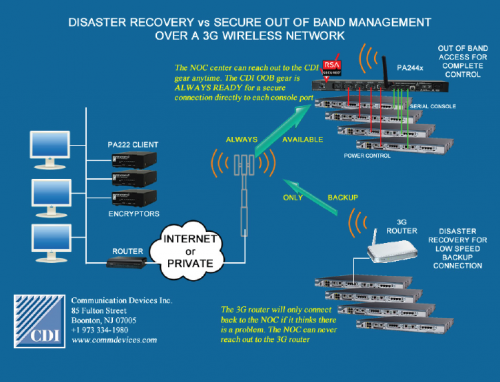Wireless Disaster Recovery vs. Wireless OBM
The 3G/4G router has become a staple for network operations personnel to ensure internet availability for remote sites if the primary network goes down. Unfortunately it does not diagnose problems with any of the network equipment at the site. The 3G/4G router is purely a disaster recovery solution and, in some cases, is being presented as an Out of Band Management solution.
Out of Band Management is “hands on” engineer access to the console port of remote network appliances. This provides console port access for device configuration, and power control reboot, of the remote devices.
Out of Band Management solutions are born out of analog modem access to the remote site. This allows always available secondary access to the remote site in the event the network or appliances are rendered unreachable via the primary network. This is being replaced by cellular wireless access where applicable.
A pure out of band management access solution needs to provide ALWAYS AVAILABLE outbound connection from the NOC to the remote site. Site outages are more likely due to equipment issues at the site than to network issues from the carrier. CDI provides always available access to console ports at the remote site thru a 3G connection. When the connection is established, the NOC center can access any of the devices directly thru CDI console port connections and can optionally power cycle locked up equipment with CDI power control modules.
As with analog modem access, security is the primary issue for cellular access. CDI is the only vendor to provide full 2 factor authentication and/or encryption without any network connection. This is important as the only reason out of band access is being used is because the network is unavailable.

The above diagram shows the difference between a Disaster Recovery solution and an Out of Band Management solution.
The disaster recovery solution only provides a “call back” connection when the 3G router senses a network outage. Appliance problems may not trigger a call back from the 3G/4G router which will leave them inaccessible for maintenance by the NOC.
The Secure OOB site can be accessed at any time by NOC personnel. The main network can be operational even if a device problem requires NOC attention. The Secure OOB site can provide secure console access along with power control all from a single device that is always available for a connection from the NOC. Remote appliances can be accessed or power cycled from a keyboard in the NOC center without a truck roll to the remote site.
The Secure OOB equipment can also be used to stand the site up from a central NOC for seamless turn ups using the expertise of engineering NOC personnel.

